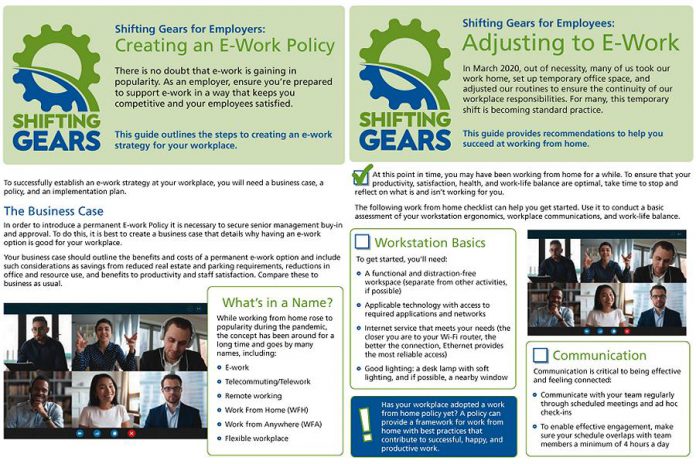
Now a familiar concept, working from home — also known as e-work, telecommuting, or remote work — was alien to many of us prior to March 2020. Little did we know that a global pandemic would allow many workplaces to trial this intriguing strategy over an extended period of time.
How exactly has COVID-19 influenced the workplace setting? Over 31 per cent of workers are now fulfilling their responsibilities from home, states an April 2021 Statistics Canada report.
That’s a whopping 27 per cent increase compared to only four per cent in 2016.
E-work is also commuting option in the annual Shifting Gears Transportation Challenge, a local workplace commuter challenge that takes place every May. The goal of the initiative is to challenge employees, workplaces, and community members to replace driving trips with walking, biking, carpooling, busing, or e-working. For many local workplaces, it’s a springtime ritual.
“In April, I write up an invitation email,” states James Britton, a manager with the Ontario Public Service and Shifting Gears coordinator for Robinson Place in downtown Peterborough. “It says, ‘May is approaching! This means the Silver Bean is opening and it’s time for Shifting Gears!'”
Much like our lives, COVID-19 has had an impact on Shifting Gears. While many participants are still walking and biking to work, many more are staying put and working from home.

This opens up a whole different approach to supporting Shifting Gears participants.
Working from home comes with unique, long-term needs, productivity and engagement impacts, and an influence on work-life balance. These considerations are important for both employer and employee.
Employers need to balance their bottom line, employee satisfaction, and goods and services output.
Providing a permanent work from home option — or a hybrid that includes time at both the work and home office — can help decrease costs, reduce office and parking needs, reduce staff sick time, and help attract and retain employees. These are the more obvious employer benefits of working from home.
For many employers, however, productivity is the unknown factor. A Stats Canada report asked workers if they felt as productive in the new home office setting. Ninety per cent of respondents said that they were at least as productive as prior to the pandemic, with 32 per cent indicating they were even more productive.
“Many people at my workplace find working from home provides a more focused, and higher, productivity time,” says Divya Dhingra, junior project lead at Lett Architects in Peterborough.

One in five respondents to the Stats Canada report indicates that a barrier to productivity is a lack of interaction with coworkers. Strategies can mitigate this.
“Every morning we have a meeting and every Tuesday afternoon a staff get-together,” Dhinga shares. “Our socialization is supported in other ways too. Every month we have virtual social gatherings and worker celebrations, like maternity leave events, where we all gather and hang out.”
Developing a work-from-home policy through employee input can improve communications strategies and support better employee productivity and satisfaction.
The Shifting Gears team has put together a toolkit to help managers with this. Creating an E-Work Policy outlines steps to engaging senior leadership, collaborating with staff, and gathering information specific to the unique situation of each workplace.
For employees, work-life balance and keeping active are key to a being successful and happy with working from home. We also created an Adjusting to E-work resource to help employees find that balance.
With little to no physical barrier between working space and living space, almost 50 per cent of employees find themselves sitting longer at their workstations. Establishing a transition routine can greatly help differentiate between work time and personal time.

Identify a couple of healthy daily habits that signify the beginning and end of the workday. Maybe it’s a walk around the neighbourhood in the morning and late afternoon. Maybe it’s a regular 20-minute stretching workout with the kids at 4:30 p.m. Identify the strategy that works best for you and stick with it.
The Shifting Gears team recommends that you practice active commuting before pandemic conditions end and you head back to a physical workplace. Plug in daily walking and cycling habits now and reap the benefits to your mental and physical health.
“I love walking,” says GreenUP’s executive director Brianna Salmon. “I bike for utilitarian purposes, for errands and exercise, but walking is much more relaxing for me. Going for a walk in the morning or after work hours allows a transition between work and home-life, even when they’re in the same space.”
“People often say to me that they like the bike ride or walk because it gives them time to think about the day ahead,” Britton adds. “It’s reflection time. It provides them with the opportunity to think through problems, arriving at work with a plan.”
Starting tomorrow, work an active “commute” transition into your day. Then complete the Shifting Gears employee checklist to learn how to further enhance your work-from-home experience.
Eighty per cent of individuals now working from home due to COVID-19 say they would like to continue to work at least half of their hours from home once the pandemic is over. This tells us that the demand is there and this work arrangement, in some form or another, is here to stay.

Optimizing the benefits of working from home now is a key foundation to enjoying those benefits as pandemic restrictions end.
Shifting Gears is delivered annually with the generous support of the City of Peterborough and numerous local organization and businesses.
For more information on the program, visit www.greenup.on.ca/shiftinggears.


























